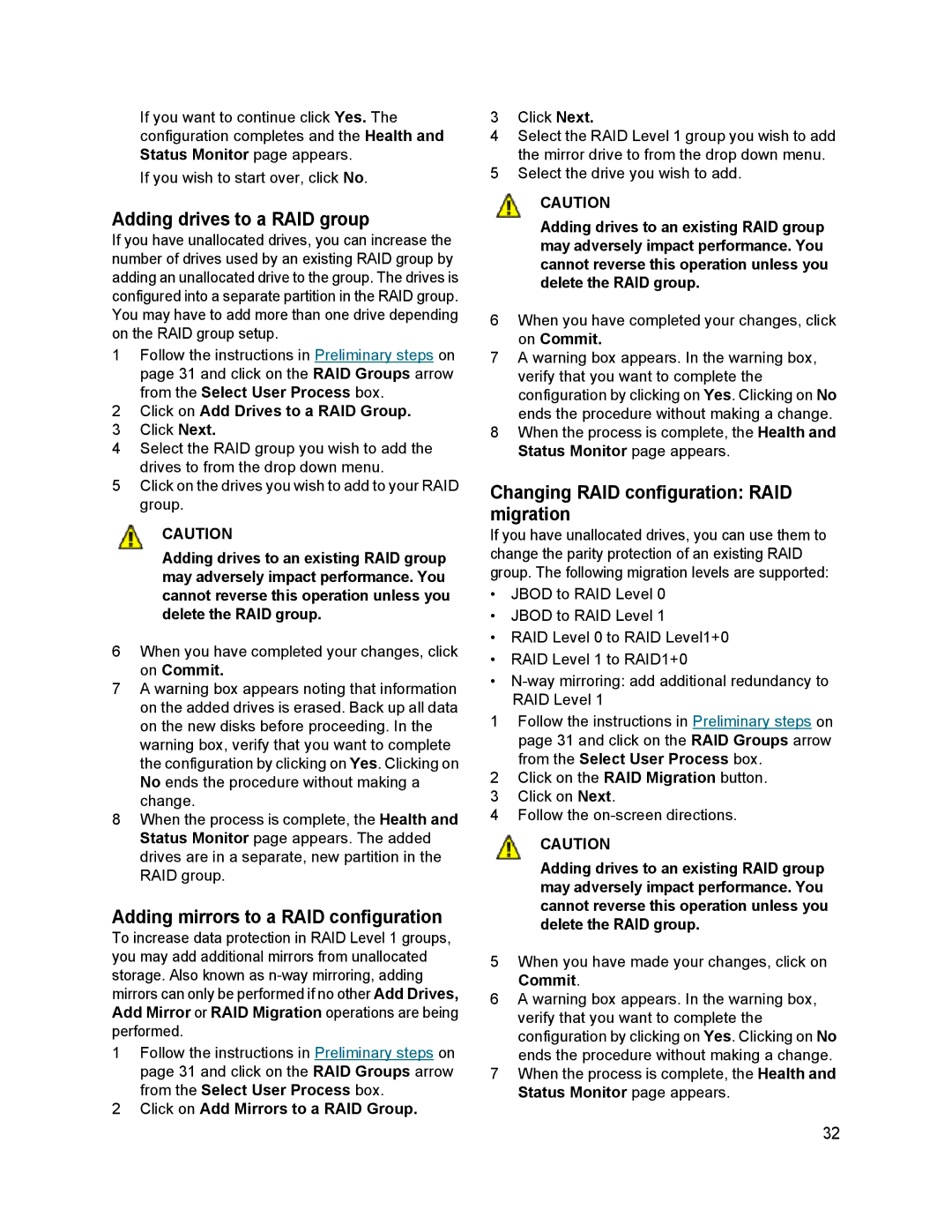
If you want to continue click Yes. The configuration completes and the Health and Status Monitor page appears.
If you wish to start over, click No.
Adding drives to a RAID group
If you have unallocated drives, you can increase the number of drives used by an existing RAID group by adding an unallocated drive to the group. The drives is configured into a separate partition in the RAID group. You may have to add more than one drive depending on the RAID group setup.
1Follow the instructions in Preliminary steps on page 31 and click on the RAID Groups arrow from the Select User Process box.
2Click on Add Drives to a RAID Group.
3Click Next.
4Select the RAID group you wish to add the drives to from the drop down menu.
5Click on the drives you wish to add to your RAID group.
CAUTION
Adding drives to an existing RAID group may adversely impact performance. You cannot reverse this operation unless you delete the RAID group.
6When you have completed your changes, click on Commit.
7A warning box appears noting that information on the added drives is erased. Back up all data on the new disks before proceeding. In the warning box, verify that you want to complete the configuration by clicking on Yes. Clicking on No ends the procedure without making a change.
8When the process is complete, the Health and Status Monitor page appears. The added drives are in a separate, new partition in the RAID group.
Adding mirrors to a RAID configuration
To increase data protection in RAID Level 1 groups, you may add additional mirrors from unallocated storage. Also known as
Add Mirror or RAID Migration operations are being
performed.
1Follow the instructions in Preliminary steps on page 31 and click on the RAID Groups arrow from the Select User Process box.
2Click on Add Mirrors to a RAID Group.
3Click Next.
4Select the RAID Level 1 group you wish to add the mirror drive to from the drop down menu.
5Select the drive you wish to add.
CAUTION
Adding drives to an existing RAID group may adversely impact performance. You cannot reverse this operation unless you delete the RAID group.
6When you have completed your changes, click on Commit.
7A warning box appears. In the warning box, verify that you want to complete the configuration by clicking on Yes. Clicking on No ends the procedure without making a change.
8When the process is complete, the Health and Status Monitor page appears.
Changing RAID configuration: RAID migration
If you have unallocated drives, you can use them to change the parity protection of an existing RAID group. The following migration levels are supported:
•JBOD to RAID Level 0
•JBOD to RAID Level 1
•RAID Level 0 to RAID Level1+0
•RAID Level 1 to RAID1+0
•
1Follow the instructions in Preliminary steps on page 31 and click on the RAID Groups arrow from the Select User Process box.
2Click on the RAID Migration button.
3Click on Next.
4Follow the
CAUTION
Adding drives to an existing RAID group may adversely impact performance. You cannot reverse this operation unless you delete the RAID group.
5When you have made your changes, click on Commit.
6A warning box appears. In the warning box, verify that you want to complete the configuration by clicking on Yes. Clicking on No ends the procedure without making a change.
7When the process is complete, the Health and Status Monitor page appears.
32
